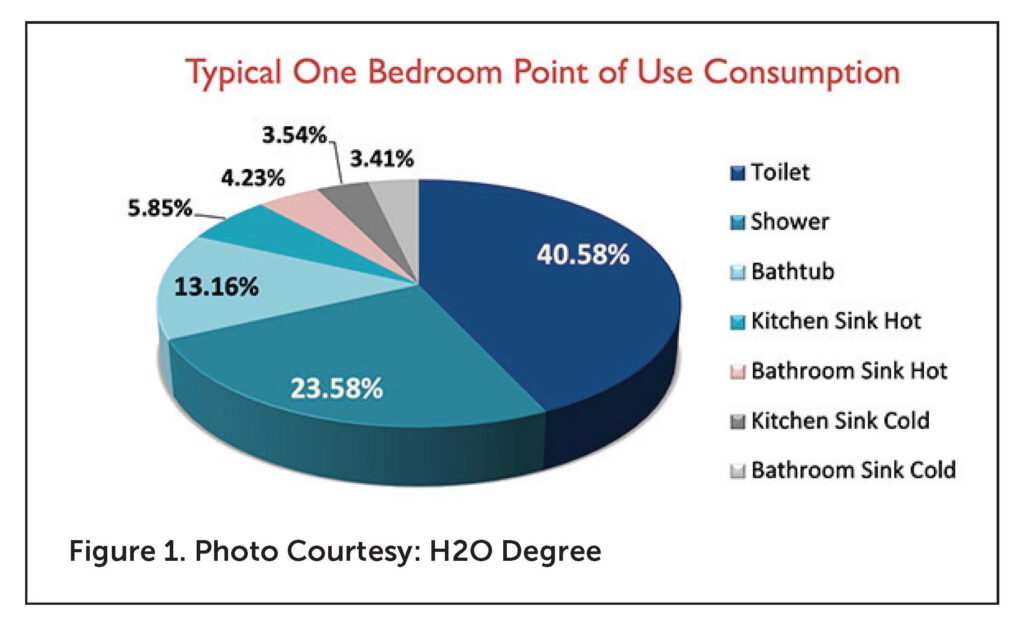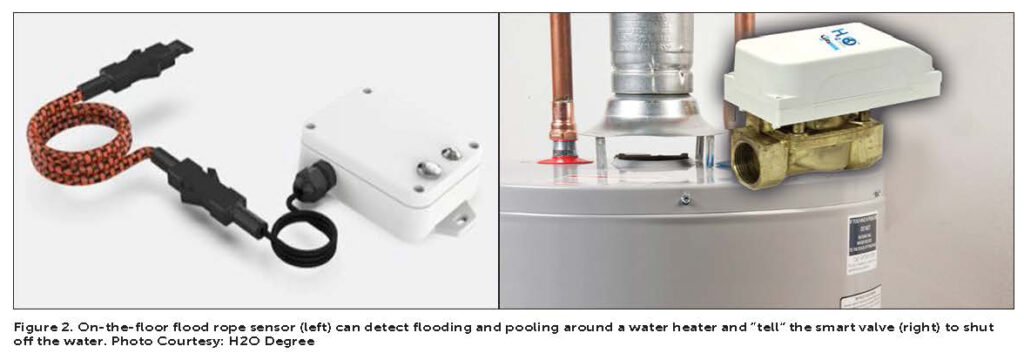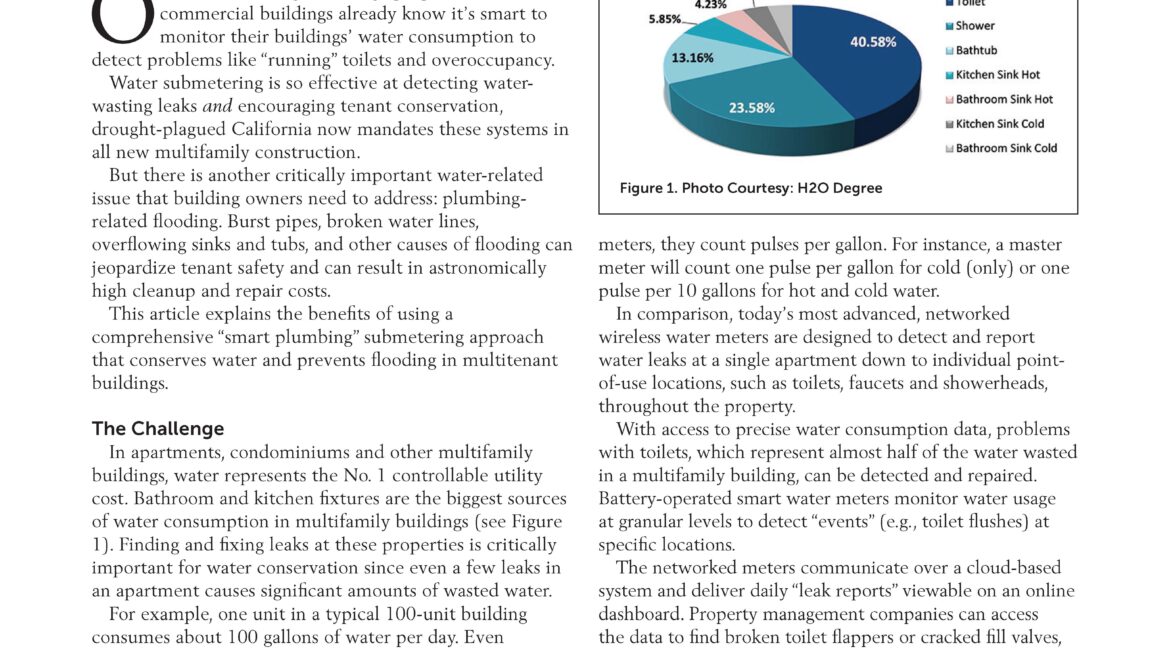
Owners and managers of large properties as well as commercial buildings already know it’s smart to monitor their buildings’ water consumption to detect problems like “running” toilets and over occupancy.
Water submetering is so effective at detecting water wasting leaks and encouraging tenant conservation, drought-plagued California now mandates these systems in all new multifamily construction.
But there is another critically important water-related issue that building owners need to address: plumbing related flooding. Burst pipes, broken water lines, overflowing sinks and tubs, and other causes of flooding can jeopardize tenant safety and can result in astronomically high cleanup and repair costs.
This article explains the benefits of using a comprehensive “smart plumbing” submetering approach that conserves water and prevents flooding in multi-tenant buildings.
The Challenge
In apartments, condominiums and other multifamily buildings, water represents the No. 1 controllable utility cost. Bathroom and kitchen fixtures are the biggest sources of water consumption in multifamily buildings (see Figure 1). Finding and fixing leaks at these properties is critically important for water conservation since even a few leaks in an apartment causes significant amounts of wasted water.
For example, one unit in a typical 100-unit building consumes about 100 gallons of water per day. Even a medium-size leak means the unit’s daily water consumption goes up to about 1,000 gallons. Therefore, if only 10 units in the building have a moderate leak, 10,000 gallons of water will be wasted every day.
Wireless Water Submetering
Wireless water submetering systems use smart water meters to monitor water consumption at precise locations all through a multi-tenant building. However, not all water meters are alike.
In a conventional water-metering scenario, a multi-unit property will have a master water meter provided by the utility collecting water usage data for the entire building.
These point-of-entry meters consist of one water meter at the street and another at the building. As pulse-output meters, they count pulses per gallon. For instance, a master meter will count one pulse per gallon for cold (only) or one pulse per 10 gallons for hot and cold water.
In comparison, today’s most advanced, networked wireless water meters are designed to detect and report water leaks at a single apartment down to individual point-of-use locations, such as toilets, faucets and showerheads, throughout the property.
With access to precise water consumption data, problems with toilets, which represent almost half of the water wasted in a multifamily building, can be detected and repaired. Battery-operated smart water meters monitor water usage at granular levels to detect “events” (e.g., toilet flushes) at specific locations.
The networked meters communicate over a cloud-based system and deliver daily “leak reports” viewable on an online dashboard. Property management companies can access the data to find broken toilet flappers or cracked fill valves, for instance, and have maintenance repair leaks before a significant amount of water is wasted. They can also give third-party billing companies or the tenants themselves access to individual consumption data to encourage water savings in order to lower their water utility bills.
Plumbing-Related Flooding
Because of the negative cost implications of flood damage in multi-unit buildings, a growing number of real estate insurance companies require property owners to install flood detection equipment as a condition of coverage. The need for flood prevention has also caused a growing number of insurance companies to offer rebates or discounts to properties that install internet-enabled flood detection
systems.

When flooding occurs, the ensuing water damage, apart from being a water conservation issue, can lead to disastrous restoration costs. Moreover, the inconvenience of cleanup and repair can shut down operations and negatively affect the occupants’ health. Flooding also poses risks to tenants, customers, employees, students and patients in the form of slip-and-fall hazards, bad air quality and mold development.
Typical sources of plumbing-related flooding include the following:
• Hot water heaters;
• Sinks, toilets, bathtubs;
• Washing machines;
• Hose-fed appliances (e.g., water coolers, ice machines, dental/medical equipment);
• HVAC overflow pans;
• Aging or frozen pipes and valves.
Internet-Based Flood Detection
Flood sensors that communicate over a LoRaWAN network are an effective solution for quickly detecting flooding. In addition to dual-probe floor sensors, on-the-floor rope sensors are designed to detect water along the full length of the 10-foot rope, which can be extended to monitor up to 3,000 mm of surface area.
When water touches the rope, the sensor transmits an alert over the open protocol communications network. The rope sensor is perfect for large areas that might not be level and/or where water might pool on one side. It can be placed all the way around sinks, washing machines, and so forth, or directly on a water or riser pipe.
The LoRaWAN floor sensors can be hardwired to LoRaWAN smart valves. The smart valve can be attached on point-of-entry or dual point-of-entry pipes on hot water heaters, washing machines, risers, irrigation and chillers. The smart valve can “talk” with multiple sensors installed throughout a building, continuously receiving “water detected” information. (And because it is battery-operated, it continues operation even if the building’s power goes out.)
Once a sensor detects water, a signal is sent over a LoRaWAN gateway via a cell phone app (Android or IOS). Depending on the situation, the user can program a “cadence” of different responses. The user, for example, can program an open/close function in the smart valve to shut off immediately upon receiving a flood alert. Or an offsite manager can shut off the water remotely or contact onsite personnel to investigate the cause of flooding (see Figure 2).
In multistory and high-rise buildings, the effects of plumbing-related flooding can be especially severe. The deluge of water coming through the ceiling can damage items in the units below, destroying furniture, artwork, electronic equipment and other expensive items, not to mention the structure itself.
An effective flood-prevention application for multistory buildings is to place smart valves on risers between the upper floors to “listen” to multiple floor sensors placed in the units above. So, for instance, if a water hose detaches from a washing machine in an upstairs unit, the floor sensors placed around the washer will wirelessly trigger the smart valve to shut off the water to all units below the riser. In other words, one smart valve placed on a riser can react to many different sensors, in many locations.
A smart approach to plumbing in multiunit buildings includes a networked, wireless water submetering system to pinpoint leaky fixtures, running toilets, and other issues that can significantly impact water consumption and drive up water utility bills. The approach is even smarter when combined with flood-detection devices that enable remote water shut-off to prevent flood damage –– before a disaster occurs.
